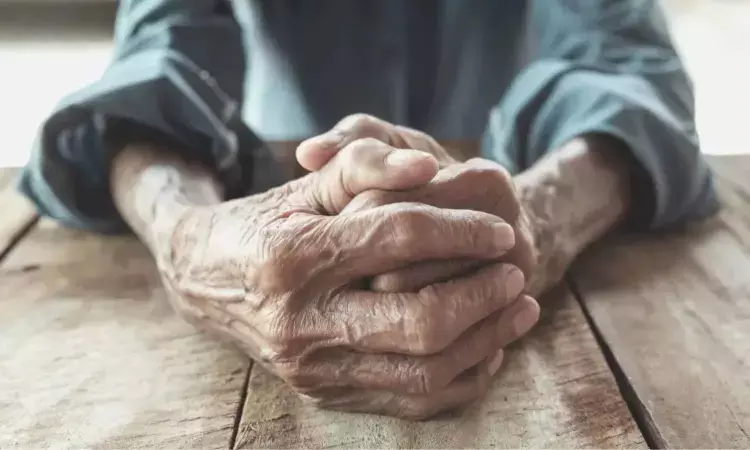- Home
- Medical news & Guidelines
- Anesthesiology
- Cardiology and CTVS
- Critical Care
- Dentistry
- Dermatology
- Diabetes and Endocrinology
- ENT
- Gastroenterology
- Medicine
- Nephrology
- Neurology
- Obstretics-Gynaecology
- Oncology
- Ophthalmology
- Orthopaedics
- Pediatrics-Neonatology
- Psychiatry
- Pulmonology
- Radiology
- Surgery
- Urology
- Laboratory Medicine
- Diet
- Nursing
- Paramedical
- Physiotherapy
- Health news
- Fact Check
- Bone Health Fact Check
- Brain Health Fact Check
- Cancer Related Fact Check
- Child Care Fact Check
- Dental and oral health fact check
- Diabetes and metabolic health fact check
- Diet and Nutrition Fact Check
- Eye and ENT Care Fact Check
- Fitness fact check
- Gut health fact check
- Heart health fact check
- Kidney health fact check
- Medical education fact check
- Men's health fact check
- Respiratory fact check
- Skin and hair care fact check
- Vaccine and Immunization fact check
- Women's health fact check
- AYUSH
- State News
- Andaman and Nicobar Islands
- Andhra Pradesh
- Arunachal Pradesh
- Assam
- Bihar
- Chandigarh
- Chattisgarh
- Dadra and Nagar Haveli
- Daman and Diu
- Delhi
- Goa
- Gujarat
- Haryana
- Himachal Pradesh
- Jammu & Kashmir
- Jharkhand
- Karnataka
- Kerala
- Ladakh
- Lakshadweep
- Madhya Pradesh
- Maharashtra
- Manipur
- Meghalaya
- Mizoram
- Nagaland
- Odisha
- Puducherry
- Punjab
- Rajasthan
- Sikkim
- Tamil Nadu
- Telangana
- Tripura
- Uttar Pradesh
- Uttrakhand
- West Bengal
- Medical Education
- Industry
Power scores during sit-to-stand motion may predict frailty in elderly with cardiometabolic disease

Ranchi Old-Age Home Residents Benefit from New Mother Teresa Clinic Initiative
In older persons with cardiometabolic illness, the speed and power ratings obtained during the sit-to-stand motion are indicative of fragility, says an article published in BMC Geriatrics.
Although sarcopenia and frailty are assessed by physical performance tests of the lower extremities, little is known about the processes by which the ground reaction force (GRF) characteristics recorded during sit-to-stand motion impact the frailty state in older persons. The goal of this study by Yuji Murao and colleagues was to investigate the relationship between GRF characteristics during a sit-to-stand action and the prevalence of frailty in older persons.
This long-term research assessed 319 outpatients with cardiometabolic illnesses who were under the age of 65. A motor function analyzer was used to test the GRF parameters and determine the power, speed, and balance scores. The Kihon Checklist (KCL) and the modified Cardiovascular Health Study (mCHS) were used to identify frailty. Multivariate binomial logistic regression analysis was used to evaluate the independent relationships between scores and frailty indicators. After controlling for confounders, the association between power and speed scores and the incidence of frailty was investigated using Cox regression analysis.
The key findings of this study were:
1. The power and speed scores were linked with frailty according to the mCHS criteria and KCL criteria at baseline, according to logistic regression models corrected for variables.
2. The area under the curve values of the power and speed scores for distinguishing mCHS-defined frailty were 0.72 and 0.73, according to receiver operating characteristic studies.
3. After correcting for variables, the Cox regression analysis revealed that the speed score predicted the incidence of frailty as defined by the mCHS and the KCL, whereas the power score was linked to the incidence of frailty as defined by the KCL.
Further research is required to determine whether exercise may enhance the GRF parameters or whether changes in these parameters are linked to an improvement in frailty status.
Reference:
Murao, Y., Ishikawa, J., Tamura, Y. et al. Association between physical performance during sit-to-stand motion and frailty in older adults with cardiometabolic diseases: a cross-sectional, longitudinal study. BMC Geriatr 23, 337 (2023). https://doi.org/10.1186/s12877-023-04011-z
Neuroscience Masters graduate
Jacinthlyn Sylvia, a Neuroscience Master's graduate from Chennai has worked extensively in deciphering the neurobiology of cognition and motor control in aging. She also has spread-out exposure to Neurosurgery from her Bachelor’s. She is currently involved in active Neuro-Oncology research. She is an upcoming neuroscientist with a fiery passion for writing. Her news cover at Medical Dialogues feature recent discoveries and updates from the healthcare and biomedical research fields. She can be reached at editorial@medicaldialogues.in
Dr Kamal Kant Kohli-MBBS, DTCD- a chest specialist with more than 30 years of practice and a flair for writing clinical articles, Dr Kamal Kant Kohli joined Medical Dialogues as a Chief Editor of Medical News. Besides writing articles, as an editor, he proofreads and verifies all the medical content published on Medical Dialogues including those coming from journals, studies,medical conferences,guidelines etc. Email: drkohli@medicaldialogues.in. Contact no. 011-43720751


